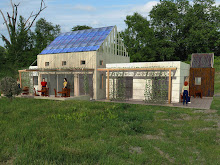 Earlier this month, we had a conference on the Unity College campus called the Art of Stewardship. 55 people braved the damp November weather to help us turn ‘campus into canvas’…identifying ways to use art as a medium to engage residents and visitors in thinking about stewardship and sustainability. The Unity House was their first destination and our first big event in this public/private space…a test of its versatility and function.
Earlier this month, we had a conference on the Unity College campus called the Art of Stewardship. 55 people braved the damp November weather to help us turn ‘campus into canvas’…identifying ways to use art as a medium to engage residents and visitors in thinking about stewardship and sustainability. The Unity House was their first destination and our first big event in this public/private space…a test of its versatility and function. The designers gave specific attention to “optimizing the thermal envelope and minimizing the space needed to accommodate various sized groups of people” creating transformable spaces within the house. The wall between the guest room and the gathering space/living room folds up, providing another 270 square feet for entertaining. We didn’t use it this time…opting to use the guest room as an entry area in the wet weather. But, the flexibility of the interior got a real workout – passing with flying colors.

The intimate living place, where we sit each night and play board games, was easily converted into an amphitheater as 55 folding chairs filled the space. We had a catering table, a registration table and a whole lot of bodies comfortably gathered for the beginning of this wonderful event. The house served as a focal point for discussions about sustainability and comfort…about possibilities of merging beauty with functional green design. The details within the space are lovely and never cease to surprise visitors who expect sustainability to equal stark, ascetic simplicity.
The interior is warm and inviting for many reasons that include both the technical and the aesthetic. The colors are a warm collection of brown tones with big timbered beams and high ceilings. The floor is a brown acid-stained concrete that looks so soft that people frequently bend down to feel the texture. The technical aspects include the thermal envelope that amasses warmth from the sun in the walls, floor and ceiling. Heat radiates back into the room from these ‘collectors’ without leaving cold spots… inhabitants feel comfortable even on cloudy days. I watched the temperature rise during the morning session. 55 bodies throw off a lot of heat! The temperature rose about seven degrees during the two hours, which kept us from turning on the heat for two days. Thermal mass and an insulating R value of 43.85 makes an enormous difference in the quality of heat we experience here.
 I thought I would miss the ‘hot spot’ that a wood stove provides. And, most of the people during the event asked whether we did miss the central heat force in our lives. We spent 30 years using wood as our main fuel source. We thought about adding a masonry wood stove to this design but our goal of ‘net-zero’ would have suffered. So, we went with a passive design, which includes about 24 feet of glass on the south side of the house and concrete floors. Our roof has a 5.4 KW PV array and solar domestic hot water system to insure our supply of electricity should we need to turn on the Hallowell heat pump. So far, we are still producing more energy than we use on a daily basis. We will see what winter in Maine brings…but I have faith in our ability to budget our energy use wisely. If we can do it in Maine, it is probably possible anywhere!
I thought I would miss the ‘hot spot’ that a wood stove provides. And, most of the people during the event asked whether we did miss the central heat force in our lives. We spent 30 years using wood as our main fuel source. We thought about adding a masonry wood stove to this design but our goal of ‘net-zero’ would have suffered. So, we went with a passive design, which includes about 24 feet of glass on the south side of the house and concrete floors. Our roof has a 5.4 KW PV array and solar domestic hot water system to insure our supply of electricity should we need to turn on the Hallowell heat pump. So far, we are still producing more energy than we use on a daily basis. We will see what winter in Maine brings…but I have faith in our ability to budget our energy use wisely. If we can do it in Maine, it is probably possible anywhere! Cindy and Mitchell Thomashow

.jpg)

No comments:
Post a Comment